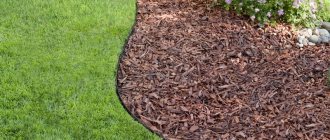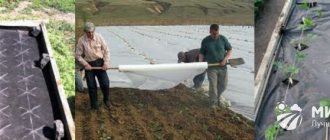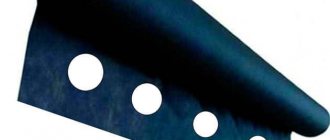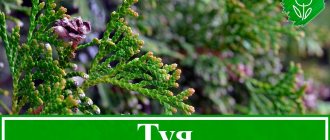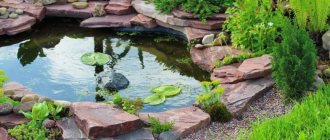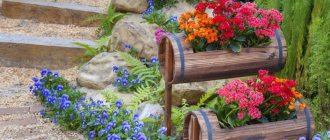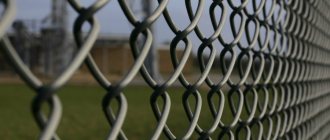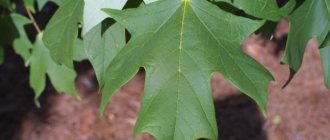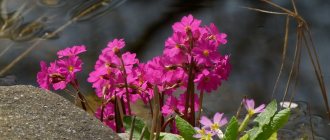Rarely a summer resident will allow weeds to grow on his site. Experienced vegetable growers and gardeners know that weeds have no benefit, but a lot of harm. Weeds take nutrition and moisture from crops, releasing toxic substances into the ground. All summer residents try to get rid of “uninvited guests” on their property by weeding their beds and flower beds throughout the summer. However, the weeds do not give up and appear again after each weeding. It is especially difficult to combat perennial weeds that reproduce by rhizomes, creeping shoots or multi-layered root suckers. Previously, such “infection” was removed from the site using black plastic film, cardboard sheets, old floor coverings and other materials that did not allow sunlight to pass through. Now manufacturers of goods intended for gardening are offering summer residents the use of non-woven weed covering material that is capable of allowing air and water to pass through, but blocking the sun's rays.
- 2 How to use covering material?
- 3 Black agrofibre or two-color material?
- 4 Agrofibre or film: which is more profitable?
- 5 The use of non-woven material when constructing paths
Types of non-woven covering materials
Nonwoven materials are produced not only to control weeds, but also to protect plants from return frosts and excessively scorching rays of the sun. Therefore, when choosing a material, you must pay attention to the manufacturer’s recommendations. Weed control material is sold on the market under different names, such as:
- "Agril";
- "Spunbond";
- "Lutrasil";
- "Agril";
- "Agrotex";
- "Lumitex";
- "Agrospan" and others.
Regardless of the name, manufacturers divide all non-woven covering materials into four groups:
- easy;
- average;
- white dense;
- black dense.
Each group is endowed with a certain set of properties and characteristics that influence the way this covering fabric is used. For example, light, low-density canvases are used to cover beds to protect seedlings from frost. Growing seedlings lift weightless material with their tops, while remaining under reliable shelter from unfavorable climate conditions. Non-woven fabrics from the fourth group, which have the highest density and are black in color, help in the fight against weeds. Thanks to its dark color, the material retains sunlight, while perfectly accumulating heat. The listed properties determine the main purpose of using non-woven material, which is to mulch beds.
Non-woven covering materials have unique qualities that allow them to inhibit the growth of weeds and ensure free penetration of moisture and air to the root system of plants
Disadvantages of using agrotextiles
1. Slugs, ants, beetle larvae (chafer beetle larvae), mole crickets and even mice can “take shelter” under agrotextiles. The most harmless of the guests are lizards, the most dangerous are vipers.
Mice love to live where agrotextiles are laid out and a layer of mulch lies: warmth and a lot of food around
2. If you do not mulch the agrotextile on top, then by the end of the season the soil underneath may become compacted and you will get the opposite effect to what you dream of. So if you are laying agrotextiles for a long time, it is better to cover it with a layer of mulch on top. This is especially important if you use spunbond and its analogues with a density of no more than 60 g/sq.m.
3. If the weeds do sprout, they will lift the fabric upward. As a rule, the problem occurs if you have laid thin and cheaper material. When using dense covering material, this happens extremely rarely.
How to use covering material?
Mulching agrofibre refers to non-woven polypropylene materials that do not cause any harm to cultivated plants, animals or people. At the same time, agrofibre does not give any chance to weeds, which die from the lack of light, trying to break through the dense material. The density of mulching covering materials is 50-60 grams per square meter.
Scheme for using non-woven weed covering material. Cultivated plants are planted in holes made with a sharp peg. Weeds die because they don't have access to sunlight.
The method of application is as follows:
- black agrofibre is spread on the soil that has dried out after winter and prepared for planting, to prevent weeds from sprouting over the entire area of the bed;
- seedlings are planted in cross-shaped slits made in the covering fabric with a sharp peg or cutting object.
The video shows how to use non-woven covering material using the example of growing strawberries:
Recent Entries
Lilac perennials that are beautiful, compact and do not crowd out other plants Why when buying seedlings you should not take the sellers’ word for it and how to determine the age of the plant using 3 signs Tomato seedlings have turned purple or whitish: why the color has changed and how to save the plants
Folk ways to eradicate grass
Among summer residents and gardeners, improvised means of controlling weeds are very popular. For example, boiling water, burning with fire using a blowtorch, and watering weeds with a solution of water and vodka are widely used. To destroy grass between paving slabs, spray with a mixture of vinegar (200 g), salt (20 g) and water (600 g).
Grass tends to grow much faster than cultivated plants. Closed beds will look quite aesthetically pleasing. And flower beds covered with tree bark or walnut husks will add zest to the landscape design of the site. You can cover the soil to prevent grass from growing using almost any available means. The main thing is that they do not allow light to pass through, but allow the soil to breathe and maintain water permeability.
Black agrofibre or two-tone material?
Amateur gardeners, as well as farmers who grow fruits and vegetables on a large scale, are freed from the need to purchase and use herbicides against weeds. They also don’t have to spend time at their summer cottages with hoes, spending a lot of physical effort and time on weeding. There are simply no weeds. Only useful crops grow in even rows.
In addition, the fruits remain clean after rains, since they do not come into contact with the ground. Strawberries grown on beds covered with agrofibre can be harvested immediately after rain. The berries lie on a dry cloth and have an excellent presentation. They can be served on the table, lightly rinsed from dust, or taken to the market for sale. Using black mulching agrofibre, you can achieve earlier ripening of the crop. It is possible to reduce the growing time of crops to two weeks by early warming up the soil under cover.
The use of mulching agrofibre eliminates a large amount of work on caring for plantings in the garden, since there is no need to weed the beds
An interesting new product has appeared in the range of covering materials - two-color mulching agrofibre, which is superior in functionality to conventional black canvases. The manufacturer has improved the product by combining two thin layers of white and black. As a result, the covering material is black on one side and white on the other. The dark side of the canvas is laid on the ground, and the light surface is on top and reflects sunlight that falls on plants and fruits from below, accelerating their growth and ripening.
Important! The white surface of the mulching two-color agrofibre prevents the root system from overheating, which affects the growth rate of crops grown on the site and the uniformity of fruit ripening.
LiveInternetLiveInternet
All summer residents are trying to get rid of “uninvited guests” on their property by weeding their beds and flower beds. However, weeds do not give up and appear again and again. It is especially difficult to deal with perennial weeds that reproduce by rhizomes, creeping shoots or multi-layered root suckers.
Previously, such “infection” was removed from the site using black plastic film, cardboard sheets, old floor coverings and other materials that did not allow sunlight to pass through.
Now manufacturers of goods intended for gardening are offering summer residents the use of non-woven weed covering material that is capable of allowing air and water to pass through, but blocking the sun's rays.
Types of non-woven covering materials Non-woven materials are produced not only to control weeds, but also to protect plants from return frosts and excessively scorching rays of the sun. Therefore, when choosing a material, you must pay attention to the manufacturer’s recommendations. Weed covering material is sold on the market under different names, such as -
- "Agril";
- "Spunbond";
- "Lutrasil";
- "Agril";
- "Agrotex";
- "Lumitex";
- "Agrospan" and others.
Regardless of the name, manufacturers divide all non-woven covering materials into four groups:
- easy;
- average;
- white dense;
- black dense.
Each group is endowed with a certain set of properties and characteristics that influence the way this covering fabric is used.
For example, light, low-density canvases are used to cover beds to protect seedlings from frost. Growing seedlings lift weightless material with their tops, while remaining under reliable shelter from unfavorable climate conditions.
Non-woven fabrics from the fourth group, which have the highest density and are black in color, help in the fight against weeds. Thanks to its dark color, the material retains sunlight, while perfectly accumulating heat. The listed properties determine the main purpose of using non-woven material, which is to mulch beds.
How to use covering material?
Mulching agrofibre refers to non-woven polypropylene materials that do not cause any harm to cultivated plants, animals or people. At the same time, agrofibre does not give any chance to weeds, which die from the lack of light, trying to break through the dense material.
The density of mulching covering materials is 50-60 grams per square meter. Scheme for using non-woven weed covering material. Cultivated plants are planted in holes made with a sharp peg. Weeds die because they don't have access to sunlight.
The method of application is as follows:
black agrofibre is spread on the soil that has dried out after winter and prepared for planting, to prevent weeds from sprouting over the entire area of the bed; seedlings are planted in cross-shaped slits made in the covering fabric with a sharp peg or cutting object.
Black agrofibre or two-tone material?
Amateur gardeners, as well as farmers who grow fruits and vegetables on a large scale, are freed from the need to purchase and use herbicides against weeds. They also don’t have to spend time at their summer cottages with hoes, spending a lot of physical effort and time on weeding. There are simply no weeds.
Only useful crops grow in even rows. In addition, the fruits remain clean after rains, since they do not come into contact with the ground. Strawberries grown on beds covered with agrofibre can be harvested immediately after rain. The berries lie on a dry cloth and have an excellent presentation. They can be served on the table, lightly rinsed from dust, or taken to the market for sale.
Using black mulching agrofibre, you can achieve earlier ripening of the crop. It is possible to reduce the growing time of crops to two weeks by early warming up the soil under cover. The use of mulching agrofibre eliminates a large amount of work on caring for plantings in the garden, since there is no need to weed the beds
An interesting new product has appeared in the range of covering materials -
two-color mulching agrofibre,
superior in functionality to conventional black canvases. The manufacturer has improved the product by combining two thin layers of white and black.
As a result, the covering material is black on one side and white on the other. The dark side of the canvas is laid on the ground, and the light surface is on top and reflects sunlight that falls on plants and fruits from below, accelerating their growth and ripening.
Important! The white surface of the mulching two-color agrofibre prevents the root system from overheating, which affects the growth rate of crops grown on the site and the uniformity of fruit ripening.
Agrofibre or film: which is more profitable?
Most farmers and amateur gardeners continue to use black plastic film to control weeds the old fashioned way.
However, it is more profitable to use mulching agrofibre, since this material:
- perfectly passes water, so watering can be organized by overhead irrigation;
- allows you to easily apply water-soluble fertilizers, which, passing through the canvas, are completely absorbed by plants;
- under the agrofibre, which allows air to pass through, mold and rot do not form, which cannot be said about plastic film;
- does not create a favorable environment for the development of pathogenic microbes that inhibit the root system of plants;
- protects the soil from drying out, due to which the top layer of soil does not compact and, therefore, does not need to be loosened;
- prevents the growth of weeds between rows, reducing labor costs.
Most modern mulching materials are designed to last from one to three years or more. When growing strawberries or wild strawberries, this is beneficial, since after a certain period of time the plantings need to be updated.
At this moment, the covering material also changes, because the resource of the old canvas is completely exhausted. The service life of the covering fabric depends on the presence of a UV stabilizer in its composition, which protects the non-woven material from the destructive effects of ultraviolet radiation.
Mulching the soil with black non-woven materials allows you to grow tomatoes in your garden plot without much hassle or physical effort
The use of non-woven material when constructing paths
To ensure that paths laid throughout the garden always have a neat appearance, it is necessary to use mulching covering material.
This canvas will prevent weeds from growing between the individual elements of the path. Since non-woven fabric is capable of transmitting water, you will not find puddles on the path after rain. All moisture will be absorbed into the soil, passing through the mulching material. After excavating the soil, the bottom of the trench is leveled and compacted. Then they spread spunbond, agrospan or another inexpensive type of covering material, covering it with crushed stone, bark, expanded clay, decorative stone or simple gravel. The trunk circles of fruit trees are decorated in a similar way.
Correct design of the trunk circle of a fruit tree. To prevent grass from breaking through from under the layer of crushed stone, you must use mulching non-woven material
Wherever there is a possibility of unwanted grass sprouting, it is necessary to lay a black non-woven covering material. This will solve the problem of weeds once and for all. Proper use of non-woven covering fabrics increases the attractiveness of the site. ( With)
Series of messages “summer ideas”:
Part 1 - COOL IDEA OF USING A WINE BARREL Part 2 - program =Garden Planner= ... Part 16 - Designing a summer cottage Part 17 - Miracle - a shovel Part 18 - Weed covering material: types, how to use, specifics Part 19 -
Agrofibre or film: which is more profitable?
Most farmers and amateur gardeners continue to use black plastic film to control weeds the old fashioned way. However, it is more profitable to use mulching agrofibre, since this material:
- perfectly passes water, so watering can be organized by overhead irrigation;
- allows you to easily apply water-soluble fertilizers, which, passing through the canvas, are completely absorbed by plants;
- under the agrofibre, which allows air to pass through, mold and rot do not form, which cannot be said about plastic film;
- does not create a favorable environment for the development of pathogenic microbes that inhibit the root system of plants;
- protects the soil from drying out, due to which the top layer of soil does not compact and, therefore, does not need to be loosened;
- prevents the growth of weeds between rows, reducing labor costs.
Most modern mulching materials are designed to last for several seasons. For example, mulch covering material against weeds from AgroLux can be on the site from a year to three or more years.
When growing strawberries or wild strawberries, this is beneficial, since after a certain period of time the plantings need to be updated. At this moment, the covering material also changes, because the resource of the old canvas is completely exhausted. The service life of the covering fabric depends on the presence of a UV stabilizer in its composition, which protects the non-woven material from the destructive effects of ultraviolet radiation.
Mulching the soil with black non-woven materials allows you to grow tomatoes in your garden plot without much hassle or physical effort
Getting rid of grass and weeds between paving slabs
We lay paving slabs for a reason. Firstly, it is beautiful and clean during bad weather. And secondly, there is no unnecessary vegetation. But it turns out that she still makes her way between this beauty. How to deal with this?
There are several simple ways:
1. Salt. It can be used both in dry and liquid form. For the first method, just lightly moisten the grass and sprinkle with salt. Or dissolve 0.5 cups of salt in a bottle of hot water. Using a sprayer, spray all tile seams. The grass will first turn yellow and then dry out completely.
2. Salt and vinegar. For this solution we need to pour 150 grams into the bottle. salt and pour 1 liter of vinegar 9%. Add about 1 tablespoon of any liquid detergent (dishing liquid or soap) there. Shake well and treat all seams overgrown with grass.
3. Soda. Make a 5 liter solution. water 3 tablespoons of soda and 1 spoon of detergent. We water the weeds with this solution and wait for the result. If necessary, the procedure can be repeated without harm to the soil.
Such methods are quite effective and simple, because everyone has these products at hand. But the paving slab area will always delight you with its well-groomed appearance.
Criteria for choosing coverage for paths between beds
To figure out which covering option for a garden path will be optimal, you first need to understand what criteria it must meet. “Indiscriminate” use of everything that comes to hand can lead to the material of the paths seriously harming the crop.
So, the coating must meet the following requirements:
- The material used is environmentally friendly, unable to harm either plants or soil during the entire period of operation.
- The coating is UV resistant and does not allow sunlight to pass through.
- The material is not afraid of moisture and is waterproof;
- Since the paths can also be used in the autumn, “waiting” for the ripening of late crops, a material is needed that is not afraid of temperature changes, even down to negative values.
- The material ideally allows air to pass through, that is, it is “breathable.”;
- The coating is strong and durable, not subject to rotting or other biological or chemical decomposition.
Read also: Tile in obi in St. Petersburg
To make it easier for readers to choose a method for making paths in the garden, options for arranging them will be considered below.
How to cover the ground to prevent weeds from growing
Although weeding is considered one of the most important and necessary procedures for caring for plants in the garden, it is difficult to find a person who would enjoy this activity. It usually happens the other way around; it is because of weeding that many people who begin to get acquainted with the wisdom of gardening quickly lose interest in these activities and prefer to buy vegetables and berries at the market than to grow them themselves. However, scientific progress does not stand still, and recently materials have appeared that can significantly facilitate the work of gardeners and gardeners and minimize the procedure for controlling weeds.
Use plants in containers
A simple way to arrange a flower bed without complicated transplanting and care is to place containers with mature plants in the garden. This can be done openly by choosing beautiful planters and placing flowers everywhere, including on hard surfaces.
Containers can also be buried in the ground. This is easier than replanting, and the roots of the flowers will be protected from diseases and parasites. If necessary, the containers can be easily dug up and moved to another part of the garden - you will not be able to do this with ordinary plants in the ground.
If you are used to preparing flower seedlings at home and then transplanting them into open ground, you should still think about containers. There are options made from compressed cardboard, which, when lowered into the ground, will gradually soften and decompose. This is environmentally friendly and simplifies the replanting process.
The best way to mulch the soil to prevent weeds from growing
The creation of a protective coating should be preceded by cleaning the soil from weeds (perennial and large) and enriching it with ash, bone meal or other slowly decomposing fertilizers.
They mulch the soil with anything: fallen leaves, mown grass, moss, straw, black film, geotextile... All this, of course, is good, but there is one more material that is often forgotten, but in vain.
We are talking about wood chips. What is it good for? Firstly, wood chips reduce the evaporation of moisture from the soil surface by about 15-20 percent. By covering the soil with a layer of 8-10 cm, we can significantly reduce watering in the summer.
The snow that fell this week in many areas of the region is not a hindrance for mulching with wood chips.
Wood chips are a good heat-insulating material. There is an even temperature regime under it: the soil does not overheat and does not crack. In the fall, it retains heat longer, giving plants more time to prepare for winter. In winter, wood chips protect the roots from frost. In spring, the ground under the mulch warms up more slowly, and, accordingly, the regrowth of leaves and shoots is delayed. However, in our area, where spring frosts are so frequent, this is only beneficial.
But not all wood chips can be used as mulch. For example, birch or oak chips have certain limitations in their use for mulching related to their chemical composition. It contains tannins that can slow down plant growth. Therefore, it is better not to use mulch from wood chips in garden beds; other materials are needed here, but coniferous plantings (spruce, thuja, cypress, etc.), which are not afraid of the tannic influence, noticeably increase their development due to the acidification of the soil on which they grow by the bark .
For coniferous plants, in the interests of improving nutrition, it is quite possible to mulch the soil with compost annually.
A serious argument in favor of mulching with bark is its combination of good thickness compared to almost weightless lightness and a high content of phytoncides that cleanse the environment of unwanted microorganisms and insects.
Bark mulch makes the tree trunk look natural.
In winter, under a blanket of crushed branches, not only the roots are comfortable. The biological activity of the soil increases sharply. For example, the number of useful underground inhabitants such as earthworms increases 4-5 times. The soil becomes more “alive”, and therefore, such mulch helps to reclaim areas that have been depleted and disturbed as a result of human carelessness and activity.
If you fill the paths with wood chips, the soil will not be compacted and washed away by rainfall (which, by the way, is important for areas on a slope). Water does not stagnate under your feet, and the house is noticeably cleaner.
Another advantage of wood chips: mulch from it prevents the growth of weeds, especially annual ones, and Roundup will help fight rhizomatous weeds.
In order for wood chips to show all their advantages, its layer must be at least 7-10 cm, otherwise the effect will be weaker. So, if you still decide to save on mulch and get by with a layer of 2-3 cm, then be prepared that you will not get rid of weeds, and if you pour too much, this can also negatively affect the plants around which it is poured .
Can all plants use mulch? In rock gardens, around bearded irises and in general all xerophytic (dry-loving) plants, wood chips will only cause harm. But daylilies, hostas, astilbe, phlox, bluebells, Siberian irises, dahlias and many other flowers will be grateful for that slightly prickly woody blanket with which a caring owner will wrap their “heels”.
And it is also very important to remember that when feeding plants under wood chip mulch, they use conventional complex fertilizers, while increasing the dose of phosphorus, and not nitrogen, as is usually done with quickly decomposing mulch materials. Wood chips decompose slowly and are “renewed” every four years.
Published: newspaper No. 199 (4490)
It's time to pay attention to the grapes
Recipes for fresh vegetables
Choose plants that will replace each other
Plan your flowerbed in such a way that the plants bloom for as long as possible, throughout the season, or replace each other. As a rule, these varieties are easy to propagate plants that will grow little by little, which is convenient if you need a large, lush flower bed or a flowering lawn in front of the house.
Perennial flowers that bloom all summer include:
- Petunias.
- Calendula.
- Armeria seaside.
- Marigold.
- Astilbe.
- Astrantia.
- Heliopsis.
- Blue delphinium.
If you choose perennials, you will save yourself the trouble of removing faded varieties in the fall and planting something to replace them in the spring.
Instagram: @elenalimonchenko Instagram: @lenuk_pleshkova
5 successful plant combinations for a spectacular flower bed
Preventing the appearance of weeds
Today there are a huge variety of methods to combat unwanted grass. Most gardeners resort to the mechanical method, i.e. weeding by hand or using appropriate tools. This method, although simple, is ineffective. To prevent grass from growing between the tiles, they begin to fight it at the stage of laying the finishing material. They do this using different methods.
Geotextiles
When finishing garden paths, geotextiles are laid at the bottom of the trench. Afterwards, a layer of sand, gravel and crushed stone is poured onto this material. Having prepared the base in this way, begin careful compaction and only after that lay the tiles or paving stones. Following this technology, you can get rid of grass for at least 20 years, which corresponds to the service life of geotextiles.
Polyethylene
By analogy with geotextiles, you can use polyethylene film. It is laid on the bottom of the trench in two layers, after which the remaining layers are laid. Polyethylene also copes well with the task, but its service life is much shorter than the previous material.
Ruberoid
Ruberoid is a thick paper that is impregnated with bitumen. This impregnation prevents the material from rotting. Ruberoid performs well as a kind of barrier and will last for several years. However, this material has one feature - before laying it on the bottom of the trench, the surface must be carefully leveled to avoid tearing.
Paper
You can also place cardboard or newspapers under the tiles. However, such materials, despite their availability and low cost, have a short service life.
The option with concrete is especially relevant if the site has a high groundwater level or if there are plans to develop a site for a car. Not a single weed can penetrate such a base under the tiles.
How to get rid of grass on your property (lawn)
Sometimes you want your yard to have a perfect lawn without a single weed. What can we say about the site itself? After all, it is almost impossible to remove weeds forever. Even herbicides help only temporarily. But even then, you don’t always want to use them. But what to do if there are so many of them, but there is practically no strength and nerves. The most accessible methods will come to our aid.
1. Herbicides. This is the fastest and most effective way. There are now a sufficient number of them in stores and they are all divided into two types:
- contact - act at the point of contact with the poison;
- systemic - when the poison gets on the plant, it penetrates into the underground part of the weed, that is, into the root. After which the plant dies completely.
According to their action, they can also be divided into those that:
- selective action;
- continuous action.
The only difference between them is that the latter destroy everything they come across and nearby. They will even destroy bushes and all the cultivated plants that you have planted. They can be used if you need a clean field without a single blade of grass.
2. Mechanical. The process involves digging, cutting or pulling out weeds. This is also an effective method, but quite labor-intensive. The area will have to be processed several times in this way. After all, not all grass sprouts at the same time. Also, the root of some weeds cannot be completely removed because it is very large. And even from the remainder of a small part in the ground, the plant will still germinate. Also, mowing the lawn is not effective, since along with the weeds, you also cut off the ornamental grass.
3. Mulching. This is a very effective, but at the same time long method. The fact is that the soil is covered with any material: agro-film, crushed stone, bark, leaves. This cover deprives the soil of sunlight, due to which photosynthesis does not occur. Consequently, a plant without light simply does not develop and dies.
The downside is that the whole process should take more than a year. In the spring you cover the soil and only remove the material the following summer. The result will amaze you! But its advantage is that moisture and heat are retained for a long time.
4. Folk. Previously, people actively used this all the time. And this also helped a lot. After all, everyone has salt and vinegar in their kitchen. You just need to act carefully so as not to touch our lawn and crops on the site.
You can sprinkle salt on slightly moistened grass or make a solution from it: 1/2 cup salt, hot water, a few drops of liquid soap. Spray the plants with a spray bottle.
Table vinegar is usually used. Mix salt (125 g), dishwashing liquid (1 tablespoon) and vinegar (1 liter). Also sprayed in the morning. It is advisable that the weather be dry and hot, then the result will be faster and better.
See, it's quite simple. The main thing is to take precautions when using harmful substances. Such methods will help you use your time not only for grass, but also for your favorite activities.
